Popular categories
Looking for a yarn?

Order DROPS Fabel from Wool Warehouse Direct Ltd

|
DROPS Fabel uni colour 75% Wool, 25% Polyamide |
2.10 $ /50g |
Order |

|
DROPS Fabel 75% Wool, 25% Polyamide |
2.30 $ /50g |
Order |

|
DROPS Fabel long print 75% Wool, 25% Polyamide |
2.45 $ /50g |
Order |
Clicking the ORDER button will redirect you to Wool Warehouse Direct Ltd website
Moorland Jumper
Knitted DROPS men’s jumper with set in sleeves in “Fabel” and Delight. Size S-XXXL.
DROPS design: Pattern no de-165
Yarn group A + A or C
----------------------------------------------------------
Size: S - M - L - XL - XXL - XXXL
Materials:
DROPS FABEL from Garnstudio
300-300-300-350-350-350 g, color no 905, salt and pepper
And use:
DROPS DELIGHT from Garnstudio
350-350-350-400-400-400 g color no 01, gray
DROPS DOUBLE POINTED NEEDLES AND CIRCULAR
NEEDLE SIZE (80 cm) 5 mm/US 8- or size needed to get 17 sts x 22 rows in stockinette st with 1 strand of each yarn = 4" x 4" (10 x 10 cm) (= 2 strands).
DROPS DOUBLE POINTED NEEDLES AND CIRCULAR
NEEDLE SIZE (40 and 80 cm/16" and 32") size 4.5 mm / US 7 (40 and 80 cm / 16" and 32") for rib - or size needed to get 18 sts x 23 rows in stockinette st with 1 strand of each yarn = 4" x 4" (10 x 10 cm) (= 2 strands).
-------------------------------------------------------
Alternative Yarn – See how to change yarns here
Yarn Groups A to F – Use the same pattern and change the yarn here
Yarn usage using an alternative yarn – Use our yarn converter here
-------------------------------------------------------
Men Men's Jumpers Men's Basic Jumpersbottom up round neck sewn in sleeves stocking stitch

Order DROPS Fabel from Wool Warehouse Direct Ltd

|
DROPS Fabel uni colour 75% Wool, 25% Polyamide 2.10 $ /50g Order |

|
DROPS Fabel print 75% Wool, 25% Polyamide 2.30 $ /50g Order |

|
DROPS Fabel long print 75% Wool, 25% Polyamide 2.45 $ /50g Order |
Clicking the ORDER button will redirect you to Wool Warehouse Direct Ltd website
- English (US/in)
- Česky
- Dansk
- Deutsch
- Eesti keel
- English (UK/cm)
- Español
- Français
- Íslenska
- Italiano
- Magyar
- Nederlands
- Norsk
- Polski
- Português
- Suomi
- Svenska
- English (UK/cm), Bulgaria
- English (UK/cm), Croatia
- English (UK/cm), Greece
- English (UK/cm), Latvia
- English (UK/cm), Lithuania
- English (UK/cm), Romania
- English (UK/cm), Slovenia
- Česky, Slovakia
Pattern instructions
K all rows. 1 ridge = K2 rows.
DECREASE TIP (evenly spaced):
To calculate how to dec evenly, use the total no of sts on row (e.g. 210 sts) and divide sts by no of dec to be done (e.g. 40) = 5.3. I.e. in this example work approx. every 4th and 5th st tog.
INCREASE TIP (front and back piece):
Inc 1 st by making 1 YO. On next row P YO twisted to avoid holes.
INCREASE TIP (sleeves):
Inc on each side of marker as follows: Work until 4 sts remains before marker, 1 YO, work 8 sts (marker is between these sts), 1 YO. On next round K YOs twisted to avoid holes.
----------------------------------------------------------
JUMPER:
Work piece in the round on circular needle up to armholes, then finish front and back piece separately. Rounds start mid back.
BODY:
Cast on 204-216-234-252-276-300 sts with 1 strand Fabel and 1 strand Delight (= 2 strands) on circular needle size 4.5 mm / US 7. K 1 round, then work rib = K 3/P 3 for 5 cm / 2". K 1 round while AT THE SAME TIME dec 40-40-42-44-52-56 sts evenly - READ DECREASE TIP (evenly spaced) = 164-176-192-208-224-244 sts. Switch to circular needle size 5 mm / US 8 and continue in the round in stockinette st. REMEMBER THE GAUGE! When piece measures 42-43-44-45-46-47 cm / 16½"-17"-17¼"-17¾"-18"-18½", insert 2 markers in the piece; first marker at after 41-44-48-52-56-61 sts and second marker after 123-132-144-156-168-183 sts. Now divide the piece at the markers and finish each part separately.
BACK PIECE:
Work back and forth.
= 82-88-96-104-112-122 sts. On next row from RS work as follows: Cast on 1 edge st (worked in garter st until finished measurements), * K 1, P 1 *, repeat from *-* a total of 3-3-3-3-4-4 times, K 1 (= 7-7-7-7-9-9 sts in rib), work in stockinette st until 7-7-7-7-9-9 sts remain, repeat from *-* a total of 3-3-3-3-4-4 times, K 1 (= 7-7-7-7-9-9 sts in rib), cast on 1 edge st (worked in garter st until finished measurements) = 84-90-98-106-114-124 sts. On next row from RS, inc 1 st in each side of section with stockinette st - Read INCREASE TIP (front and back piece). Inc like this every 3rd-4th-5th-7th-9th-12th row 10-9-7-6-5-4 times in total = 104-108-112-118-124-132 sts. Work the new sts in stockinette st. Continue in stockinette st and rib until piece measures 58-60-62-64-66-68 cm / 22¾"-23⅝"-24⅜"-25¼"-26"-26¾", then bind off the middle 28-30-32-34-36-36 sts for neck and finish each shoulder separately. Bind off 2 st on next row from neck = 36-37-38-40-42-46 sts remain on each shoulder. Loosely bind off all sts when piece measures 60-62-64-66-68-70 cm / 23⅝"-24⅜"-25¼"-26"-26¾"-27½".
FRONT PIECE:
Work as on back piece. When piece measures 52-54-55-57-58-60 cm / 20½"-21¼"-21½"-22½"-22¾"-23½", slip the middle 16-18-18-18-20-20 sts on a stitch holder for neck and finish each shoulder separately. Then bind off sts on every row from neck as follows: bind off 4 sts 1 time, 2 sts 2 times, and 1 st 0-0-1-2-2-2 times = 36-37-38-40-42-46 sts remain on each shoulder. Loosely bind off when piece measures 60-62-64-66-68-70 cm / 23⅝"-24⅜"-25¼"-26"-26¾"-27½".
SLEEVES:
Worked in the round on double pointed needles.
Cast on 48-48-54-54-54-60 sts with 1 strand Fabel and 1 strand Delight (= 2 strands) on double pointed needles size 4.5 mm / US 7. K 1 round, then work rib = K 3/P 3. Continue rib until piece measures 7 cm / 2¾". On next round, dec 8-6-10-8-8-12 sts evenly = 40-42-44-46-46-48 sts. Switch to double pointed needles size 5 mm / US 8. Then work in stockinette st. When piece measures 8-8-8-8-11-11 cm / 3"-3"-3"-3"-4½"-4½", insert a marker at beg of round (= mid under sleeve). Move the marker upwards when working. On next round inc 1 st in each side of marker mid under sleeve - Read INCREASE TIP (sleeves)! Inc like this approx. every 10th-9th-9th-8th-6th-5th round 10-11-11-12-14-16 times in total = 60-64-66-70-74-80 sts. Continue until piece measures 52-52-51-51-50-49 cm / 20½"-20½"-20"-20"-19¾"-19¼" (shorter measurements in the larger sizes because of wider shoulders). Then loosely bind off all sts. Make another sleeve.
ASSEMBLY:
Sew the shoulder seams. Sew in sleeves inside 1 edge st.
NECK EDGE:
Pick up from RS on circular needle size 4.5 mm / US 7 approx. 96-114 sts (includes sts from stitch holder mid front) with 1 strand Fabel and 1 strand Delight (= 2 strands). Work rib * K 3, P 3 * in the round until rib measures 3 cm / 1". Loosely bind off sts with K over K and P over P. Fasten off.
Diagram
All measurements in charts are in cm.
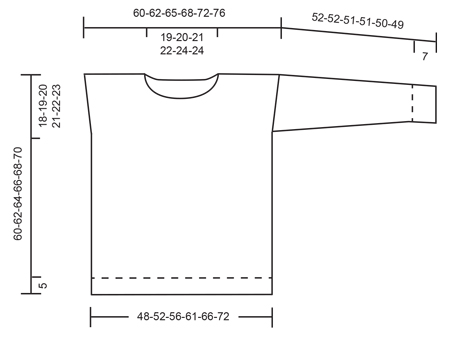
What can you do with our patterns? You can share DROPS patterns online, using the pattern original picture, materials, name and number. But you are NOT ALLOWED to reproduce the complete pattern digitally in any way. Yarn stores are welcome to use the DROPS pattern database to promote the sale of our assortment. You can print out our patterns, make as many copies as you’d like. The only thing we ask is that you don't make any changes / additions to the original printed document. And that the patterns according to the DROPS philosophy are given out to the consumers for free. Editorials that wish to publish our patterns in printed books or magazines can contact us for more information. The sale of garments based on DROPS patterns is permitted as long as they are sold as single items or per order. Further commercial use of the patterns is not permitted. It has to be clearly stated that the garment is made based on a design from DROPS DESIGN. The use of clothing labels of which DROPS DESIGN forms part is conditioned by the inclusion of the following text: “A DROPS DESIGN made by …..”. The use of DROPS photos for marketing purposes/sales is only permitted in connection with the use/sale of DROPS products. The photos may not be cut or edited and the logo should be clearly visible.
We reserve the right to withdraw the permission for use of our patterns at any time, notwithstanding the reason.
Each of our patterns has specific tutorial videos to help you.
These step-by-step tutorials might also help you:
Why is the knitting/crochet tension so important?
Knitting tension is what determines the final measurements of your work, and is usually measured per 10 x 10 cm. It is provided like so: number of stitches in width x number of rows in height - eg: 19 stitches x 26 rows = 10 x 10 cm.
The knitting tension is very individual; some people knit/crochet loosely while others work tightly. You adjust the knitting tension with the needle size, which is why the suggested needle size only serve as a guide! You need to adjust this (up or down) to ensure that YOUR knitting tension matches the knitting tension provided in the pattern. If you work with a different knitting tension than provided you will have a different yarn consumption, and your work will have different measurements than what the pattern suggests.
The knitting tension also determines which yarns can replace each other. As long as you achieve the same knitting tension you can replace one yarn with another.
See DROPS lesson: How to measure your tension/gauge
See DROPS video: How to make a gauge tension swatch
How do I know how many balls of yarn I need?
The required amount of yarn is provided in grams, eg: 450 g. To calculate how many balls you’ll need you first need to know how many grams are in 1 ball (25g, 50g or 100g). This information is available if you click on the individual yarn quality on our pages. Divide the amount required with the amount of each ball. For example, if each ball is 50g (the most common amount), the calculation will be as follows: 450 / 50 = 9 balls.
Can I use a different yarn than what the pattern suggests?
The important thing when changing from one yarn to another is that the knitting/crochet tension remains the same. This is so that the measurements of the finished piece will be the same as on the sketch provided. It is easier to achieve the same knitting tension using yarns from the same yarn group. It is also possible to work with multiple strands of a thinner yarn to achieve the knitting tension of a thicker one. Please try our yarn converter. We recommend you to always work a test swatch.
Please NOTE: when changing yarn the garment might have a different look and feel to the garment in the photo, due to individual properties and qualities of each yarn.
See DROPS lesson: Can I use a different yarn than the one mentioned in the pattern?
What are the yarn groups?
All our yarns are categorised into yarn groups (from A to F) according to thickness and knitting tension – group A contains the thinnest yarns and group F the thickest. This makes it easier for you to find alternative yarns to our patterns, should you wish to switch yarn. All yarns within the same group have a similar knitting tension and can easily replace each other. However, different yarn qualities have different structures and properties which will give the finished work a unique look and feel.
How do I use the yarn converter?
At the top of all our patterns you’ll find a link to our yarn converter, which is a helpful tool should you wish to use a different yarn than suggested. By filling in the yarn quality you wish to replace, the amount (in your size) and number of strands, the converter will present good alternative yarns with the same knitting tension. Additionally it will tell you how much you’ll require in the new qualities and whether you’ll need to work with multiple strands. Most skeins are 50g (some are 25g or 100g).
If the pattern is worked with multiple colours, every colour will have to be converted separately. Similarly, if the pattern is worked with several strands of different yarns (for example 1 strand Alpaca and 1 strand Kid-Silk) you will have to find alternatives for each, individually.
Why do you show discontinued yarns in the patterns?
Since different yarns have different qualities and textures we have chosen to keep the original yarn in our patterns. However, you can easily find options among our available qualities by using our yarn converter, or simply pick a yarn from the same yarn group.
It is possible that some retailers still have discontinued yarns in stock, or that someone has a few skeins at home that they would like to find patterns for.
The yarn converter will provide both alternative yarn as well as required amount in the new quality.
What size should I knit?
If you think it's hard to decide what size to make, it can be a good idea to measure a garment you own already and like the size of. Then you can pick the size by comparing those measures with the ones available in the pattern's size chart.
You'll find the size chart at the bottom of the pattern.
See DROPS lesson: How to read size chart
Why do I get the wrong knitting tension with the suggested needle size?
The needle size provided in the pattern serves only as a guide, the important thing is to follow the knitting tension. And since knitting tension is very individual, you will have to adjust the needle size to ensure that YOUR tension is the same as in the pattern – maybe you’ll have to adjust 1, or even 2 needle sizes, up or down to achieve the correct tension. For this, we recommend that you work test swatches.
Should you work with a different knitting tension than the one provided, the measurements of the finished garment might deviate from the measurement sketch.
See DROPS lesson: How to measure your tension/gauge
See DROPS video: How to make a gauge tension swatch
Why is the pattern worked top-down?
Working a garment top-down provides more flexibility and room for personal adjustment. For example it is easier to try the garment on while working, as well as making adjustments to length of yoke and shoulder caps.
The instructions are carefully explaining every step, in the correct order. Diagrams are adjusted to the knitting direction and are worked as usual.
How do I work according to a knitting diagram?
The diagram depicts all rows/rounds, and every stitch seen from the right side. It is read from bottom to top, from right to left. 1 square = 1 stitch.
When working back and forth, every other row is worked from the right side and every other row is worked from the wrong side. When working from the wrong side, the diagram will have to be worked reversed: from left to right, knit stitches are purled, purl stitches are knit etc.
When working in the round every round is worked from the right side and the diagram are worked from right to left on all rounds.
See DROPS lesson: How to read knitting diagrams
How do I work according to a crochet diagram?
The diagram depicts all rows/rounds, and every stitch seen from the right side. It is worked from bottom to top, from right to left.
When working back and forth every other row is worked from the right side: from right to left and every other row is worked from the wrong side: from left to right.
When working in the round, every row in the diagram are worked from the right side, from right to left.
When working a circular diagram you start in the middle and work your way outwards, counter clockwise, row by row.
The rows usually start with a given number of chain stitches (equivalent to the height of the following stitch), this will either be depicted in the diagram or explained in the pattern.
See DROPS lesson: How to read crochet diagrams
How do I work several diagrams simultaneously on the same row/round?
Instructions for working several diagrams after each other on the same row/round, will often be written like so: “work A.1, A.2, A.3 a total of 0-0-2-3-4 times". This means you work A.1 once, then A.2 is worked once, and A.3 is repeated (in width) the number of times provided for your size – in this case like so: S = 0 times, M = 0 times, L=2 times, XL= 3 times and XXL = 4 times.
The diagrams are worked as usual: begin with the first row in A.1, then work the first row in A.2 etc.
See DROPS lesson: How to read knitting diagrams
See DROPS lesson: How to read crochet diagrams
Why are the sleeves shorter in larger sizes?
The total width of the garment (from wrist-to-wrist) will be larger in the larger sizes, despite the actual sleeves being shorter. The larger sizes have longer sleeve caps and wider shoulders, so there will be a good fit in all sizes.
Where on the garment is the length measured?
The measurement sketch/schematic drawing provides information regarding the full length of the garment. If it’s a jumper or a jacket the length is measured from the highest point on the shoulder (usually closest to the neckline), and straight down to the bottom of the garment. It is NOT measured from the tip of shoulder. Similarly, the length of yoke is measured from the highest point on the shoulder and down to where yoke is split into body and sleeves.
See DROPS lesson: How to read a schematic drawing
What is a repeat?
Diagrams are often repeated on the round or in height. 1 repeat is the diagram the way it appears in the pattern. If it says to work 5 repeats of A.1 in the round, then you work A.1 a total of 5 times after/next to each other in the round. If it says to work 2 repeats of A.1 vertically/in height you work the entire diagram once, then begin again at the start and work the entire diagram one more time.
Why does the piece start with more chain stitches than it’s worked with?
Chain stitches are slightly narrower than other stitches and to avoid working the cast-on edge too tight, we simply chain more stitches to begin with. The stitch count will be adjusted on the following row to fit the pattern and measurement sketch.
Why increase before the rib edge when the piece is worked top-down?
The rib edge is more elastic and will contract slightly compared to, for example, stocking stitch. By increasing before the rib edge, you avoid a visible difference in width between the rib edge and the rest of the body.
Why increase in the cast-off edge?
It’s very easy to cast off too tightly, and by making yarn overs while casting off (and simultaneously casting these off) you avoid a too tight cast off edge.
See DROPS video: How to bind off with yarn overs (yo)
How do I increase/decrease on every 3rd and 4th row/round alternately?
To achieve an even increase (or decrease) you can increase on, for example: every 3rd and 4th row alternately, like so: work 2 rows and increase on the 3rd row, work 3 rows and increase on the 4th. Repeat this until the increase is complete.
See DROPS lesson: Increase or decrease 1 st on every 3rd and 4th row alternately
How can I work a jacket in the round instead of back and forth?
Should you prefer to work in the round instead of back and forth, you may of course adjust the pattern. You’ll need to add steeks mid-front (usually 5 stitches), and follow the instructions. When you would normally turn and work from the wrong side, simply work across the steek and continue in the round. At the end you’ll cut the piece open, pick up stitches to work bands, and cover the cut edges.
See DROPS video: How to knit steeks and cut open
Can I work a jumper back and forth instead of in the round?
Should you prefer to work back and forth instead of in the round, you may of course adjust the pattern so you work the pieces separately and then assemble them at the end. Divide the stitches for the body in 2, add 1 edge stitch in each side (for sewing) and work the front and back pieces separately.
See DROPS lesson: Can I adapt a pattern for circular needles into straight needles?
Why is the pattern slightly different than what I see in the photo?
Pattern repeats can vary slightly in the different sizes, in order to get the correct proportions. If you’re not working the exact same size as the garment in the photo, yours might deviate slightly. This has been carefully developed and adjusted so that the complete impression of the garment is the same in all sizes.
Make sure to follow instructions and diagrams for your size!
How do I make a women’s size garment into a men’s size one?
If you have found a pattern you like which is available in women’s size it’s not very difficult to convert it to men’s size. The biggest difference will be the length of sleeves and body. Start working on the women size that you think would fit across the chest. The additional length will be worked right before you cast off for the armhole/sleeve cap. If the pattern is worked top-down you can add the length right after the armhole or before the first decrease on sleeve.
Regarding additional yarn amount, this will depend on how much length you add, but it is better with a skein too many than too few.
How do I prevent a hairy garment from shedding?
All yarns will have excess fibres (from production) that might come off as lint or shedding. Brushed yarns (ie hairier yarns) have more of these loose, excess fibres, causing more shedding.
Shedding also depends on what is worn under or over the garment, and whether this pulls at the yarn fibres. It’s therefore not possible to guarantee that there will be no shedding
Below are some tips on how to get the best result when working with hairier yarns:
1. When the garment is finished (before you wash it) shake it vigorously so the looser hairs come off. NOTE: do NOT use a lint roller, brush or any method that pulls at the yarn.
2. Place the garment in a plastic bag and put it in your freezer - the temperature will cause the fibres to become less attached to each other, and excess fibres will come off easier.
3. Leave in the freezer for a few hours before taking it out and shaking it again.
4. Wash the garment according to the instructions on the yarn label.
Why does my garment pill?
Pilling is a natural process that happens to even the most exclusive of fibers. It's a natural sign of wear and tear that is hard to avoid, and that is most visible in high friction areas of your garment like a sweater's arms and cuffs.
You can make your garment look as new by removing the pilling, using a fabric comb or a pill/lint remover.
In the meantime, you can read the questions and answers that others have left to this pattern or join the DROPS Workshop on Facebook to get help from fellow knitters/crocheters!
You might also like...
Moorland Jumper |
|
 |
 |
Knitted DROPS men’s jumper with set in sleeves in “Fabel” and Delight. Size S-XXXL.
DROPS 174-9 |
|
|
GARTER ST (back and forth): K all rows. 1 ridge = K2 rows. DECREASE TIP (evenly spaced): To calculate how to dec evenly, use the total no of sts on row (e.g. 210 sts) and divide sts by no of dec to be done (e.g. 40) = 5.3. I.e. in this example work approx. every 4th and 5th st tog. INCREASE TIP (front and back piece): Inc 1 st by making 1 YO. On next row P YO twisted to avoid holes. INCREASE TIP (sleeves): Inc on each side of marker as follows: Work until 4 sts remains before marker, 1 YO, work 8 sts (marker is between these sts), 1 YO. On next round K YOs twisted to avoid holes. ---------------------------------------------------------- JUMPER: Work piece in the round on circular needle up to armholes, then finish front and back piece separately. Rounds start mid back. BODY: Cast on 204-216-234-252-276-300 sts with 1 strand Fabel and 1 strand Delight (= 2 strands) on circular needle size 4.5 mm / US 7. K 1 round, then work rib = K 3/P 3 for 5 cm / 2". K 1 round while AT THE SAME TIME dec 40-40-42-44-52-56 sts evenly - READ DECREASE TIP (evenly spaced) = 164-176-192-208-224-244 sts. Switch to circular needle size 5 mm / US 8 and continue in the round in stockinette st. REMEMBER THE GAUGE! When piece measures 42-43-44-45-46-47 cm / 16½"-17"-17¼"-17¾"-18"-18½", insert 2 markers in the piece; first marker at after 41-44-48-52-56-61 sts and second marker after 123-132-144-156-168-183 sts. Now divide the piece at the markers and finish each part separately. BACK PIECE: Work back and forth. = 82-88-96-104-112-122 sts. On next row from RS work as follows: Cast on 1 edge st (worked in garter st until finished measurements), * K 1, P 1 *, repeat from *-* a total of 3-3-3-3-4-4 times, K 1 (= 7-7-7-7-9-9 sts in rib), work in stockinette st until 7-7-7-7-9-9 sts remain, repeat from *-* a total of 3-3-3-3-4-4 times, K 1 (= 7-7-7-7-9-9 sts in rib), cast on 1 edge st (worked in garter st until finished measurements) = 84-90-98-106-114-124 sts. On next row from RS, inc 1 st in each side of section with stockinette st - Read INCREASE TIP (front and back piece). Inc like this every 3rd-4th-5th-7th-9th-12th row 10-9-7-6-5-4 times in total = 104-108-112-118-124-132 sts. Work the new sts in stockinette st. Continue in stockinette st and rib until piece measures 58-60-62-64-66-68 cm / 22¾"-23⅝"-24⅜"-25¼"-26"-26¾", then bind off the middle 28-30-32-34-36-36 sts for neck and finish each shoulder separately. Bind off 2 st on next row from neck = 36-37-38-40-42-46 sts remain on each shoulder. Loosely bind off all sts when piece measures 60-62-64-66-68-70 cm / 23⅝"-24⅜"-25¼"-26"-26¾"-27½". FRONT PIECE: Work as on back piece. When piece measures 52-54-55-57-58-60 cm / 20½"-21¼"-21½"-22½"-22¾"-23½", slip the middle 16-18-18-18-20-20 sts on a stitch holder for neck and finish each shoulder separately. Then bind off sts on every row from neck as follows: bind off 4 sts 1 time, 2 sts 2 times, and 1 st 0-0-1-2-2-2 times = 36-37-38-40-42-46 sts remain on each shoulder. Loosely bind off when piece measures 60-62-64-66-68-70 cm / 23⅝"-24⅜"-25¼"-26"-26¾"-27½". SLEEVES: Worked in the round on double pointed needles. Cast on 48-48-54-54-54-60 sts with 1 strand Fabel and 1 strand Delight (= 2 strands) on double pointed needles size 4.5 mm / US 7. K 1 round, then work rib = K 3/P 3. Continue rib until piece measures 7 cm / 2¾". On next round, dec 8-6-10-8-8-12 sts evenly = 40-42-44-46-46-48 sts. Switch to double pointed needles size 5 mm / US 8. Then work in stockinette st. When piece measures 8-8-8-8-11-11 cm / 3"-3"-3"-3"-4½"-4½", insert a marker at beg of round (= mid under sleeve). Move the marker upwards when working. On next round inc 1 st in each side of marker mid under sleeve - Read INCREASE TIP (sleeves)! Inc like this approx. every 10th-9th-9th-8th-6th-5th round 10-11-11-12-14-16 times in total = 60-64-66-70-74-80 sts. Continue until piece measures 52-52-51-51-50-49 cm / 20½"-20½"-20"-20"-19¾"-19¼" (shorter measurements in the larger sizes because of wider shoulders). Then loosely bind off all sts. Make another sleeve. ASSEMBLY: Sew the shoulder seams. Sew in sleeves inside 1 edge st. NECK EDGE: Pick up from RS on circular needle size 4.5 mm / US 7 approx. 96-114 sts (includes sts from stitch holder mid front) with 1 strand Fabel and 1 strand Delight (= 2 strands). Work rib * K 3, P 3 * in the round until rib measures 3 cm / 1". Loosely bind off sts with K over K and P over P. Fasten off. |
|

|
|
|
Have you made this or any other of our designs? Tag your pictures in social media with #dropsdesign so we can see them! Do you need help with this pattern?You'll find tutorial videos, a Comments/Questions area and more by visiting the pattern on garnstudio.com. © 1982-2024 DROPS Design A/S. We reserve all rights. This document, including all its sub-sections, has copyrights. Read more about what you can do with our patterns at the bottom of each pattern on our site. |
|
With over 40 years in knitting and crochet design, DROPS Design offers one of the most extensive collections of free patterns on the internet - translated to 17 languages. As of today we count 304 catalogs and 11422 patterns - 11417 of which are translated into English (US/in).
We work hard to bring you the best knitting and crochet have to offer, inspiration and advice as well as great quality yarns at incredible prices! Would you like to use our patterns for other than personal use? You can read what you are allowed to do in the Copyright text at the bottom of all our patterns. Happy crafting!







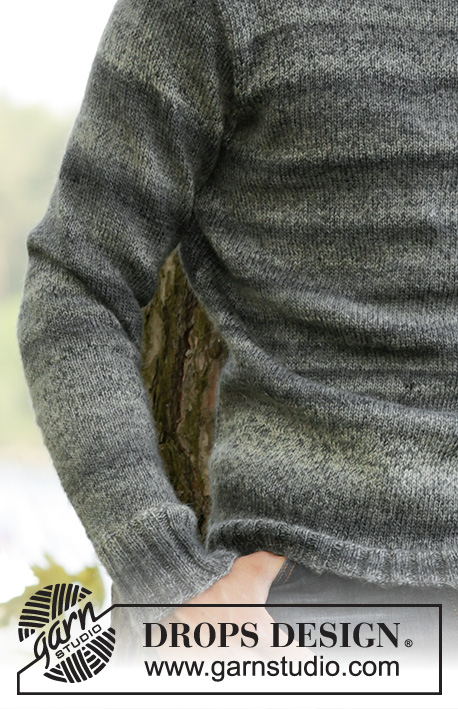

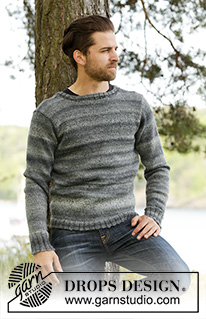
















































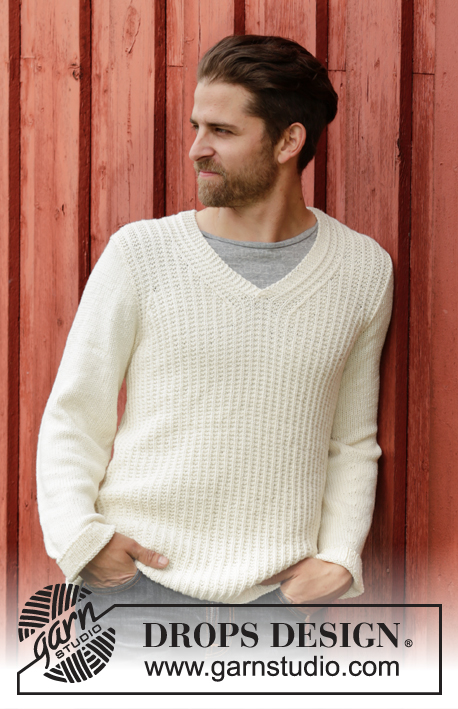
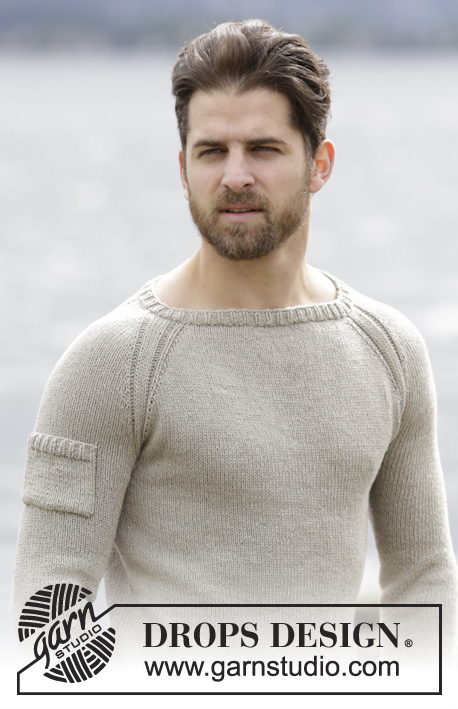
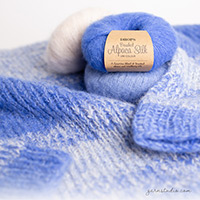





Comments / Questions (69)
Re: length of sleeve...I am following the 3rd size up and the pattern says knit until work measures 51cm. However the schematic size has a further 7cm for the cuff making 58cm.... Am I missing something?
13.02.2020 - 11:44DROPS Design answered:
Dear Daphne, the sleeve in 3rd size should be 51 cm as shown in the chart, these 51 cm include the 7 cm ribbing at the bottom. Happy knitting!
13.02.2020 - 12:19I'm confused from where it separates, reading other questions I realise there is meant to be ribbing on arm hole edges inside of last st. But why is the pattern increasing for arm hole instead of decreasing? I've not made a round jumper before and understand that the sleeve will fit in the separated bit as there will be an opening for it, but normal jumpers (back and forth on circular needles ) decrease at arm hole? Kind regards
15.12.2019 - 07:56DROPS Design answered:
Dear Tiffany, in this pattern, you will have to increase for armholes to give the desired shape for the jumper - see measurement chart. Happy knitting!
16.12.2019 - 08:24Buongiorno. Non mi è chiaro come dividere le maglie tra il davanti ed il dietro. Seguendo le istruzioni per la taglia Small dovrei mettere il primo segno dopo 41 maglie ed il secondo dopo 123...ma a questo punto mi ritroverei al primo segno essendo 164 le maglie totali. Potete chiarire per favore? Grazie
27.09.2019 - 06:59DROPS Design answered:
Buongiorno Cinzia. Le 123 maglie vanno contate dall’inizio del giro; il secondo segno viene messo quindi dopo 82 maglie dal primo. Ci devono essere 82 maglie sia per il davanti che per il dietro. Buon lavoro!
27.09.2019 - 10:14Str. L, jeg har sat 2 mærker, efter 48m og 144. 1. Skal jeg begynde at lave rygstk på 48m? 2. Skal jeg også slå 1 kantm.op hverside start fra 1 omg (før først maske og efter sidst maske)? Målet er 96, dvs jeg skal slå 24 kant masker op hvis jeg laver det hverside? Tak for hjælpe
01.09.2019 - 09:56DROPS Design answered:
Hei Lucky Klipp tråden, legg opp 1 maske (= kantmaske) og start i 48. maske, strikk mønster forklart i oppskriften, legg opp 1 maske (=kantmaske) = 98 masker. Første rad av bakstykket er nå strikket. På neste pinne fra RETTEN skal det økes med 1 maske i hver side av glattstrikkpartiet. Øk slik på hver 5.pinne totalt 7 ganger = 112 masker (du har økt med 14 masker). God Fornøyelse!
02.09.2019 - 13:13Is het correct dat er niet meer gesproken wordt te meerderen na de boord..volgens mij zit daar een fout waardoor het hele werk niet meer klopt...erg vervelend!Voorals nadat jd bij het splitsen daar achter komt!
14.04.2019 - 17:41Dag mevrouw, Kan ik deze trui ook met 2 draden Fabel breien?
14.04.2019 - 16:59DROPS Design answered:
Dag Hanneke,
Dat zou inderdaad kunnen, want fabel valt in garengroep A. Maak altijd even een proeflapje en pas evt. even de naalddikte aan voor de juiste stekenverhouding.
14.04.2019 - 19:23Hi. im newbie in knitting, i wonder in part Back Piece, it say ((on next row from right side work as follows: Cast on 1 edge st )). is that mean? i make new knit from right side until finish 96 st (size L), in wrong side i make purl and finish it till 96 st. thank so much for help
06.04.2019 - 07:08DROPS Design answered:
Dear Haru, it means, that you should make a new stitc at the end of the next two rows, that will be the edge stitch (later used as a seam when sewing up the pieces). The edge stitches are generally knitted in garter stitch (knitting the stitch in each row). Happy Knitting!
07.04.2019 - 05:26Hej! Ska ökningarna på bak- och framstycke göras precis innan resp. efter kantmaskan?
23.03.2019 - 10:58DROPS Design answered:
Hej. Ökningarna görs i varje sida av partiet med slätstickning, dvs i övergången mellan resåren och slätstickningen på varje sida. Lycka till!
25.03.2019 - 13:12Hej! Jag undrar ang. avmaskningen för hals på bak- och framstycke: Ska 4-2-2 avmaskningarna (framstycket) göras varvet direkt efter att de 16 maskorna för halsen satts på tråd? Eller i slutet av axelpartiet, när axeln nästan är färdigstickad?
13.03.2019 - 22:29DROPS Design answered:
Hej. Avmaskningarna gör du direkt efter att du har satt maskorna för halsen på en tråd. Lycka till!
14.03.2019 - 08:47Hallo. Kann ich anstatt DROPS Delight und DROPS Fabel auch zwei die DROPS Delight verwenden?
13.03.2019 - 15:30DROPS Design answered:
Liebe Jo Ann, ja gerne, Delight und Fabel sind beige Garngruppe A - benutzen Sie unseren Garnumrechner, um die neue Garnmenge zu kalkulieren. Viel Spaß beim stricken!
13.03.2019 - 16:08